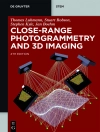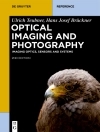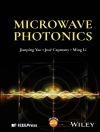Meeting the need for a reliable publication on the topic and reflecting recent breakthroughs in the field, this is a comprehensive overview of color quality of solid-state light sources (LED-OLED and laser) and conventional lamps, providing academic researchers with an in-depth review of the current state while supporting lighting professionals in understanding, evaluating and optimizing illumination in their daily work.
Jadual kandungan
INTRODUCTION
Brief History of the Development of Artificial Light Sources
Lighting Quality Aspects
Aims, Functionality and Applications of Lighting and Light Sources
Fluorescent Lamps and the Development of the Color Rendering Index
Color Rendering Index: Current Definition
Other Metrics of Color Quality: A Systematic View of Color Quality (Color Rendition) Metrics
Aims and Structure of the Book
COLOR APPEARANCE: PHENOMENA AND METRICS
Human Eye Physiology, Color Perception and Cognitive Color
Color Appearance Phenomena
Distortion of Color Appearance Under Different Artificial Light Sources
The System of Color Quality Metrics
System of Subjective Attributes of Color Quality and Their Descriptors
Summary: Lessons Learnt for Lighting Practice
THE WAITE POINT OF THE LIGHT SOURCE
Color Matching: the Metameric Effect
Chromaticity of Unique White
Preferred White Tones
Summary: Lessons Learnt for Lighting Practice
OBJECT COLORS: SPECTRAL REFLECTANCE, GROUPING OF COLORED OBJECTS AND COLOR GAMUT ASPECTS
Sampling, Grouping and Weighting of Object Colors Based on Their Spectral Reflectance Properties
Spectral Reflectance of Flowers
Spectral Reflectance of Skin Tones
Spectral Reflectance of Art Paintings
The Leeds Database of Object Colors
Summary: Lessons Learnt for Lighting Practice
VISUAL COLOR QUALITY ASPECTS: REULTS AND CONSEQUENCES FROM VISUAL STUDIES
Aims of Visual Color Quality Studies
Methodology of Visual Color Quality Studies
Visual Study on Color Fidelity (Color Realness) Based on Color Difference Adjustment
Visual Study on the Semantic Interpretation of Color Differences and Color Rendering Indices
Visual Color Quality Studies on Color Preference, Vividness and Naturalness
Visual Color Quality Studies on Color Discrimination and Color Gamut
Visual Experiments on Color Memory and on Cognitive Color Aspects Color
Summary: Lessons Learnt for Lighting Practice
VISUAL COLOR QUALITY EXPERIMENTS AT THE TECHNISCHE UNIVERSITÄT DARMSTADT
Motivation and Aim of the Visual Color Quality Experiments
Experiment on Chromatic Visual Clarity
Brightness Matching of Strongly Metameric White Light Sources
Correlated Color Temperature Preference for White Objects
Color Temperature Preference of Illumination with Red, Blue and Colorful Object Combinations
Visual Experiments on Color Quality in a Three-Chamber Viewing Booth
Experiments on Color Preference, Naturalness and Vividness in a One-Chamber Viewing Booth
Experiment on Long-Term Memory Colors
Summary: Lessons Learnt for Lighting Practice
CORRELATIONS OF COLOR QUALITY METRICS
Sample Set of Test Light Sources
Correlations Among Color Quality Metrics Using Their Own Test Color Samples
Correlations Among Color Quality Metrics Using Different Sets of Test Color Samples
Summary: Lessons Learnt for Lighting Practice
OPTIMIZATION OF LED LIGHT ENGINES FOR HIGH COLOR QUALITY
Optimization Concepts for Lighting Design
State of the Art of LED Technology
Comprehensive Spectral Modeling of LEDs (Colored Semiconductor LEDs and Phosphor- Converted White LEDs)
Optimization Schemes for the Spectral Design of LED Light Engines
Optimization for Color Fidelity (CIECRI 2012, CIE Ra, IES Rf 2015)
Comprehensive Optimization for Different Color Quality Aspects
Comprehensive Multi-Metric Color Quality Optimization by the Variation of LED Peak Wavelengths and LED Phosphor Systems
Summary: Lessons Learnt for Lighting Practice
HUMAN CENTRIC LIGHTING AND COLLOR QUALITY
Principles of Human Centric Lighting and Color Quality
The Circadian Stimulus in the Rea et al. Model
Spectral Design for HCL Co-Optimizing Circadian Aspects and Color Quality
Summary: Lessons Learnt for Lighting Practice
CONCLUSIONS AND OUTLOOK
Mengenai Pengarang
Tran Quoc Khanh is University Professor and Head of the Laboratory of Lighting Technology at the TU Darmstadt in Darmstadt, Germany. He obtained his Ph D degree in Lighting Engineering from the TU Ilmenau, Germany. He obtained his Degree of Lecture Qualification (Habilitation) from the same University for his thesis in Colorimetry and Color Image Processing. He gathered industrial experience as a project manager at ARRI Cine Technik in München (Germany). Tran Quoc Khanh authored and co-authored numerous scientific publications and invented several patents in different domains of lighting technology.
Peter Bodrogi is senior research fellow at the Laboratory of Lighting Technology of the TU Darmstadt in Darmstadt, Germany. He obtained his Ph D degree in Information Technology from the University of Pannonia. He obtained his Degree of Lecture Qualification (Habilitation) from the TU Darmstadt in 2010 for his thesis on the optimization of modern visual technologies. He co-authored numerous scientific publications and invented patents in the domains of self-luminous display technology and lighting technology.
Quang Trinh Vinh is senior research fellow at the Laboratory of Lighting Technology of the TU Darmstadt in Darmstadt, Germany. He obtained his ME Degree in regulation technology. He obtained his Dr.-Ing. degree from the TU Darmstadt in 2013. His research subject concerns the complex mathematical modeling of high-power (phosphor-converted) LEDs, including their electric, thermal and optical behavior, and their light quality and color quality. He co-authored several scientific publications and invented patents in LED lighting technology.












